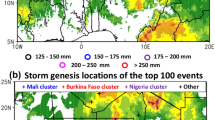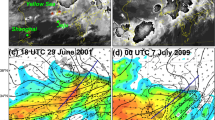Abstract
An investigation was conducted to describe the locations of initial occurrence, evolution and structure of meso-α-scale lows (MLs) associated with cloud clusters and heavy rainfall over the Korean Peninsula using observation and reanalysis data. We selected 29 heavy rainfall events associated with MLs during the 10-year period of 2001-2010. The locations of initial ML occurrence are widely spread from the eastern flank of the Tibetan Plateau to the Yellow Sea. These locations are grouped into 3 regions: 1) the eastern flank of the Tibetan Plateau (R1, 6 cases), 2) central and eastern China (R2, 16 cases), and 3) the Yellow Sea (R3, 7 cases). Initial MLs tend to occur within a deep trough over the eastern flank of the Tibetan Plateau (R1 cases) or a long trough extended northeastward from the southeast of the Tibetan Plateau along the northwestern rim of the western Pacific subtropical high (a majority of R2 cases and two R3 cases). Horizontal temperature gradients are weak over the areas of initial MLs. Meso-α-scale lows tend to develop in the lower troposphere (e.g., below 700 hPa) in an environment of existing cyclonic vorticity. And they are accompanied by anticyclonic vorticity in the upper troposphere. The speed of ML movement varies with each case and with the location of ML. The average speeds of ML movement are 32.4, 37.2 and 40.4 km h-1 for the R1, R2 and R3 groups, respectively. Meso-α-scale lows are shown to have a warm-core structure in general. They are tilted toward various directions with a majority of them (14 of 29 MLs) tilting northward with height.
Similar content being viewed by others
References
Akiyama, T. 1978: Mesoscale pulsation of convective rain in mediumscale disturbances developed in Baiu front. J. Meteor. Soc. Japan, 56, 267–283.
Akiyama, T., 1984b: A medium-scale cloud cluster in a Baiu front. Part II: Thermal and kinematic fields and heat budgets. J. Meteor. Soc. Japan, 62, 505–521.
Bao, X., and F. Zhang, 2013: Impacts of the mountain-plains solenoid and cold pool dynamics on the diurnal variation of warm-season precipitation over northern China. Atmos. Chem. Phys., 13, 6965–6982.
Bei, N. F., S. X. Zhao, and S. T. Gao, 2002: Numerical simulation of a heavy rainfall event in China during July 1998. Meteor. Atmos. Phys., 80, 153–164.
Chen, S.-J., and L. Dell’Osso, 1986: The effect of Qinghai-Tibet Plateau forcing on the meso-scale rain-bearing circulation systems over Eastern China during presummer rainy season. J. Meteor. Soc. Japan, 64, 53–63.
Chen, S.-J., Y.-H. Kuo, P.-J. Zhang, and Q.-F. Bai, 1991: Synoptic climatology of cyclogenesis over East Asia, 1958–1987. Mon. Wea. Rev., 119, 1407–1418.
Ding, Y., Y. Zhang, M. Qiang, and H. Guoquan, 2001: Analyses of the large-scale circulation features and synoptic systems in East Asia during the Intensive Observation Period of GAME/HUBEX. J. Meteor. Soc. Japan, 79, 277–300.
Jung, W., and T.-Y. Lee, 2013: Formation and evolution of mesoscale convective systems that brought the heavy rainfall over Seoul on September 21, 2010. Asia-Pac. J. Atmos. Sci., 49, 635–647.
Lee, T.-Y., and Y.-H. Kim, 2007: Heavy precipitation systems over the Korean peninsula and their classification. J. Korean Meteor. Soc., 43, 367–396.
Matsumoto, S., S. Yoshizumi, and M. Takeuchi, 1970: On the structure of the “Baiu Front” and the associated intermediate-scale disturbances in the lower atmosphere. J. Meteor. Soc. Japan, 48, 479–491.
Murakami, T., and W.-G. Huang, 1984: Orographic effects of the Tibetan Plateau on the rainfall variations over central china during the 1979 summer. J. Meteor. Soc. Japan, 62, 895–909.
Ninomiya, K., and T. Akiyama, 1971: The development of the mediumscale disturbance in the Baiu front. J. Meteor. Soc. Japan, 49, 663–677.
Ninomiya, K., and K. Yamazaki, 1979: Heavy rainfalls associated with frontal depression in Asia subtropical humid region. Part 2. J. Meteor. Soc. Japan, 57, 399–413.
Ninomiya, K., and H. Muraki, 1986: Large scale circulation over East Asia during Baiu period of 1979. J. Meteor. Soc. Japan, 64, 409–429.
Ninomiya, K., and T. Akiyama, 1992: Multi-scale features of Baiu, the summer Monsoon over Japan and the east Asia. J. Meteor. Soc. Japan, 70, 467–494.
Park, S.-U., I.-H. Yoon, and S.-K. Chung, 1986: Heat and moisture sources associated with the Changma front during the summer of 1978. J. Korean Meteor. Soc., 22, 1–27.
Qian, J. H., W. K. Tao, and K. M. Lau, 2004: Mechanisms for torrential rain associated with the Mei-yu development during SCSMEX 1998. Mon. Wea. Rev., 132, 3–27.
Saha, S., and Coauthors, 2010: The NCEP Climate Forecast System Reanalysis. Bull. Amer. Meteor. Soc., 91, 1015–1057.
Shinoda, T., and H. Uyeda, 2002: Effective factors in the development of deep convective clouds over the wet region of eastern China during the summer monsoon season. J. Meteor. Soc. Japan, 80, 1395–1414.
Tagami, H., H. Niino, and T. Kato, 2007: A study of meso-α-scale disturbances on the Baiu front and their environmental field. J. Meteor. Soc. Japan, 85, 767–784.
Tochimoto, E., and T. Kawano, 2012: Development processes of Baiu frontal depressions. Sci. Online Lett. Atmos., 8, 9–12.
Wang, B., and I. Orlanski, 1987: Study of a heavy rain vortex formed over the eastern flank of the Tibetan Plateau. Mon. Wea. Rev., 115, 1370–1393.
Wang, C. C., and G. T. J. Chen, and R. E. Carbone, 2004: A climatology of warm-season cloud patterns over East Asia based on GMS infrared brightness temperature observations. Mon. Wea. Rev., 132, 1606–1609.
Yang, Y. M., W. L. Gu, R. L. Zhao, and J. Liu, 2010: The statistical analysis of low-level vortex during Mei-yu season in the lower reaches of the Yangtze (in Chinese). J. Appl. Meteorol. Sci., 21, 11–18.
Yoshizumi, S., 1977: On the structure of intermediate-scale disturbances on the Baiu front. J. Meteor. Soc. Japan, 55, 107–120.
You, C.-H., D.-I. Lee, S.-M. Jang, M. Jang, H. Uyeda, T. Shinoda, and F. Kobayashi, 2010: Characteristics of rainfall systems accompanied with Changma front at Chujado in Korea. Asia-Pac. J. Atmos. Sci., 46, 41–51.
Zhang, Y., L. Zhang, C. Wang, Y. Xie, and Xiang, 2014: Mechanism of a torrential rainstorm that occurred to the west of a Mei-yu frontal low. Asia-Pac. J. Atmos. Sci., 50, 437–452.
Author information
Authors and Affiliations
Corresponding author
Rights and permissions
About this article
Cite this article
Shin, U., Lee, TY. Origin, evolution and structure of meso-α-scale lows associated with cloud clusters and heavy rainfall over the Korean peninsula. Asia-Pacific J Atmos Sci 51, 259–274 (2015). https://doi.org/10.1007/s13143-015-0076-3
Received:
Accepted:
Published:
Issue Date:
DOI: https://doi.org/10.1007/s13143-015-0076-3




